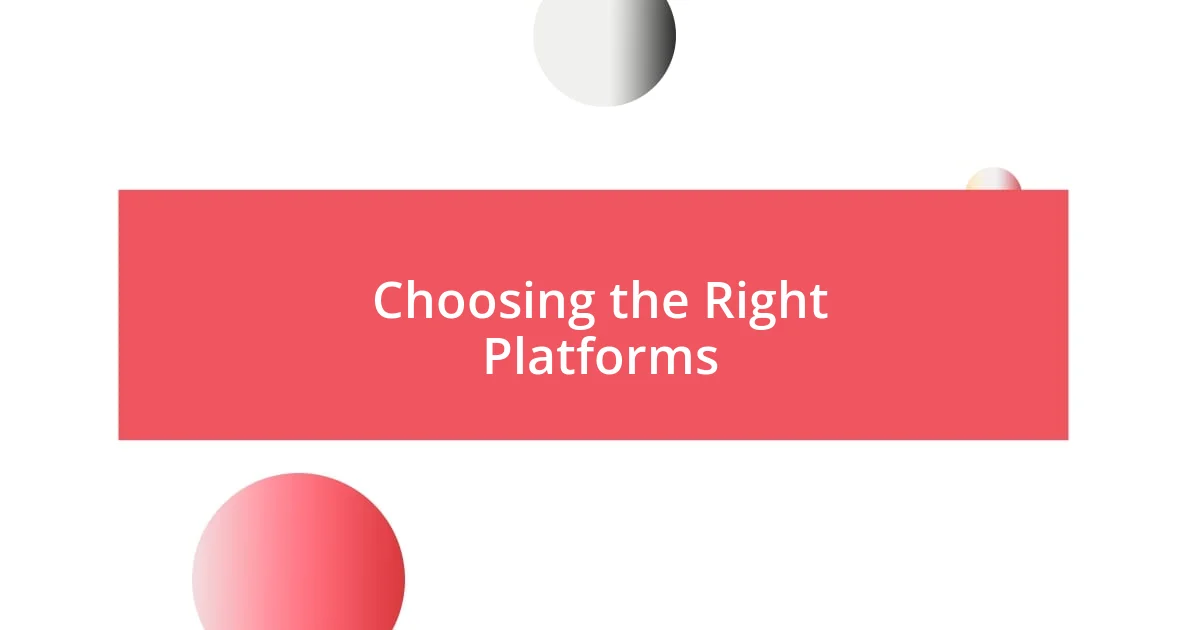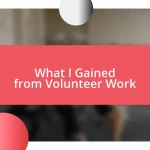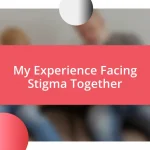Key takeaways:
- Identifying personal support needs involves reflection and creating a list, helping clarify what kind of support is desired for emotional well-being.
- Choosing the right social media platforms enhances the support experience, with Facebook for groups, Twitter for real-time conversation, and Instagram for visual inspiration.
- Sharing personal journeys openly online fosters connections and encourages others to engage, creating a supportive community that validates shared experiences and deepens relationships.

Identifying Your Support Needs
Identifying your support needs starts with a moment of reflection. I still remember sitting alone, overwhelmed by life’s challenges, and wondering what exactly I needed to feel better. Was it a listening ear, shared experiences, or maybe just some advice? This process can often feel daunting, but it’s crucial to pinpoint what truly resonates with you.
Think about the times when you felt isolated or uncertain. Did you crave companionship, or did you need someone to offer guidance? For me, reaching out to a couple of online communities made all the difference. I realized I wasn’t just looking for advice; I wanted connection, a sense of belonging in a world that felt so chaotic.
Creating a list of what you need can help clarify your thoughts. I remember jotting down my needs one evening and feeling a weight lift off my shoulders. It’s empowering to see your thoughts on paper—it transforms vague feelings into tangible needs, making them easier to communicate when you do reach out for support. Have you tried articulating your support needs before? It’s truly a step towards finding the help you deserve.

Choosing the Right Platforms
Choosing the right social media platforms for support can significantly impact your experience. In my case, I found that platforms like Facebook offer diverse groups where individuals share their stories and offer encouragement. For example, joining a mental health support group on Facebook opened my eyes to a network of people who understood my struggles, making the chaotic world feel a bit more manageable.
When I explored Twitter, I was surprised by the power of hashtags. They can create communities around specific issues, allowing for real-time conversations with others facing similar challenges. I vividly recall a night when I posted about a tough day and found solace in the supportive replies I received within minutes. It’s incredible how a few words can create a sense of belonging, even when you’re physically alone.
Ultimately, it’s essential to consider your comfort level and the type of engagement you’re seeking. Do you prefer one-on-one connections through direct messages or the broader outreach of public forums? For me, platforms like Instagram provided a nice blend—I could follow uplifting content creators while also sharing my journey. This helped me feel simultaneously connected and inspired, striking the perfect balance for my support needs.
| Platform | Best For |
|---|---|
| Diverse support groups | |
| Real-time conversations | |
| Visual inspiration and connection |

Building a Supportive Community
Building a supportive community through social media can be a transformative experience. I recall stumbling upon a small Facebook group dedicated to sharing stories about mental health. Initially, I felt hesitant to participate, but witnessing others openly share their struggles inspired me to jump in and share mine. The welcoming comments I received made me realize I was surrounded by people who not only understood my feelings but also validated them. It’s remarkable how a digital space can become a haven for emotional support.
Here are some insights on fostering a supportive community online:
- Engagement: Actively contribute by commenting, sharing your experiences, or asking questions. This creates a two-way street of support.
- Consistency: Regularly check in with your chosen communities to nurture relationships and provide ongoing encouragement to others.
- Openness: Be genuine in sharing your thoughts and challenges. Authenticity invites reciprocity and builds trust among members.
- Inclusivity: Welcome and support newcomers in the group, as it helps expand the sense of community and belonging for everyone involved.
Each interaction is an opportunity to deepen connections within your supportive network—trust me, it makes a world of difference.

Engaging with Your Audience
Engaging with your audience on social media is not just about broadcasting your message; it’s about fostering connection. I remember the first time I hosted an Instagram Live session where I opened up about my journey. I shared a vulnerable moment, and the flood of comments and questions made me realize how many people were eager to engage. Isn’t it amazing how a simple act of sharing can create a powerful dialogue? The warmth and encouragement that poured in from the viewers turned what felt like a solo experience into a shared journey.
Responding to comments and messages promptly is another essential part of engagement that I’ve found invaluable. After posting about a particularly challenging week, I took the time to reply to each person who reached out. Their stories mirrored mine, and through those exchanges, I felt a renewed sense of connection. Have you ever considered how investing time in these interactions can make a world of difference? It’s not just about support; it’s about building relationships that enrich your experience on these platforms.
As I navigated various groups, I found that asking for advice or sharing a question could spark meaningful conversations. One day, I asked for tips on coping strategies, and within hours, I was met with a cascade of thoughtful responses. It was refreshing to see how people were not only willing to support me but also genuinely invested in sharing their own experiences. This collaborative spirit highlights the essence of community—everyone has something to contribute, and every interaction can lead to deeper understanding and solidarity.

Sharing Your Journey Openly
Opening up about your journey online can be daunting yet liberating. I vividly remember the first time I posted about my struggles with anxiety on Twitter. The response was overwhelming; people I hadn’t spoken to in years reached out, sharing their own stories and offering support. It struck me how many others were silently navigating similar struggles, and it was a reminder that vulnerability can forge vital connections.
There’s something powerful about sharing your truth with a wider audience. When I decided to create a YouTube video about my healing process, I felt both nervous and excited. The outpouring of love and shared experiences in the comments made it clear that I wasn’t alone in my feelings. Have you ever felt that rush of relief from revealing a part of yourself? I found that by being transparent about my difficulties, I not only enhanced my own healing but also encouraged others to speak their truths.
Sharing openly isn’t just about storytelling; it’s an invitation for others to join in a collective experience. I recall posting a raw moment during a particularly tough day, and I was amazed by how many people responded with encouragement. Why do you think that is? It’s because honesty resonates. When we’re genuine about our struggles, it gives others permission to do the same, fostering a deeper sense of community and understanding.

Evaluating the Impact of Support
Evaluating the impact of support received through social media can be quite revealing. I remember analyzing the feedback from a series of posts I made about my mental health journey. Each like, share, and heartfelt comment served as tangible tokens of connection, affirming the value of my shared experience. Have you ever paused to consider how often a simple message can validate someone’s feelings? It’s remarkable how our online interactions can leave a lasting impression.
Reflecting on the encouragement I received during challenging times, I noticed a pattern: the more I engaged, the deeper the support became. One memorable instance was when a friend reached out after I posted a particularly raw update. They didn’t just offer sympathy—they shared their own struggles, creating a nuanced dialogue that lifted my spirits. Isn’t it interesting how our vulnerabilities can unlock such meaningful exchanges? This mutual support not only bolstered my resolve but also inspired others to share, amplifying the sense of solidarity within our community.
Ultimately, what I’ve discovered is that the collective impact of social media support is profound. By valuing every interaction, I learned that each person’s response contributes to a larger narrative of connection and healing. For instance, after a group discussion about coping strategies, I received a message from someone expressing how my story motivated them to seek help. Can you imagine the ripple effect we create when we choose to share our journeys? It’s moments like these that remind me that our experiences, shared openly, can resonate far beyond what we initially envision.















